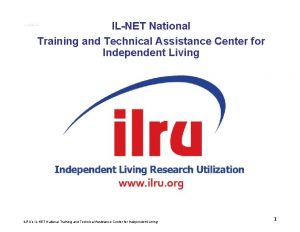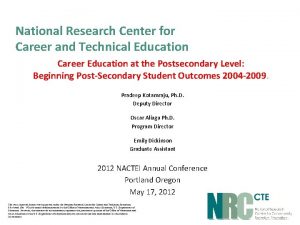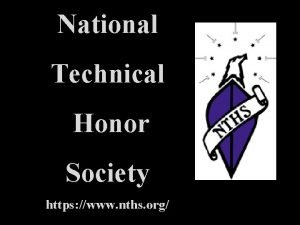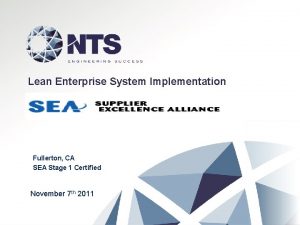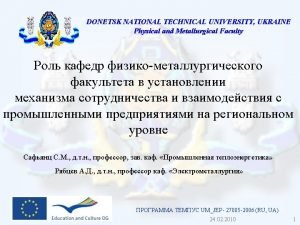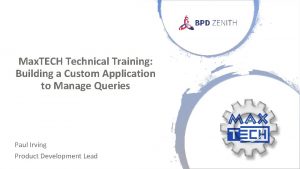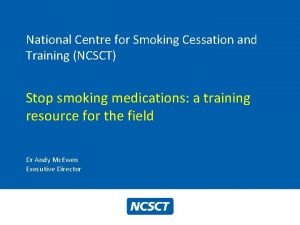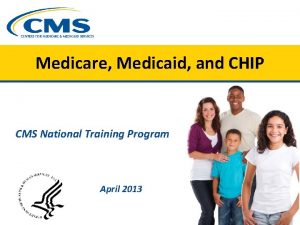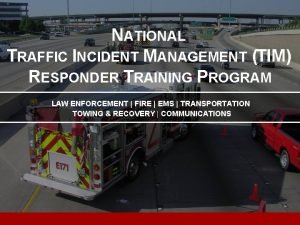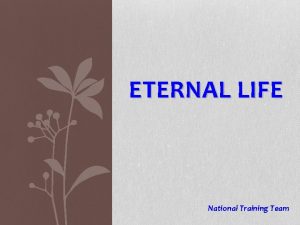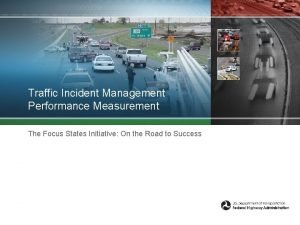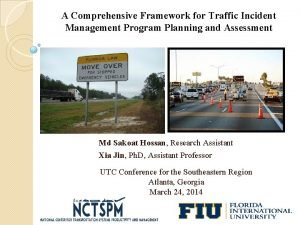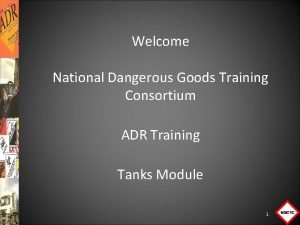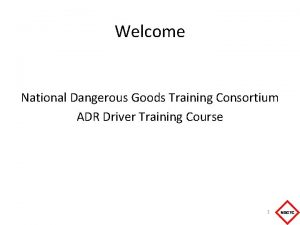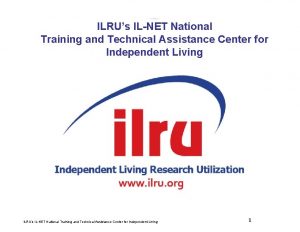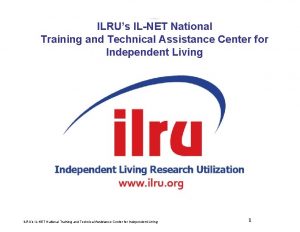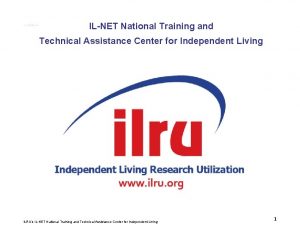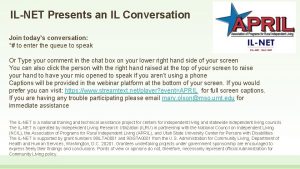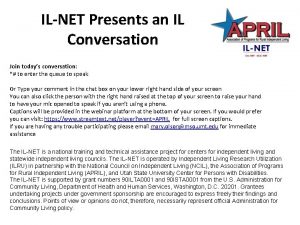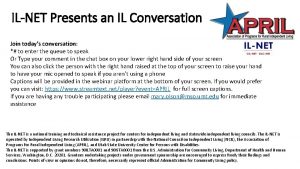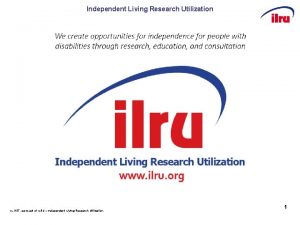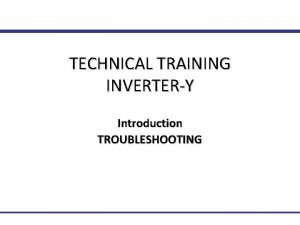Slide 1 ILRUs ILNET National Training and Technical



















- Slides: 19

>>Slide 1 ILRU’s IL-NET National Training and Technical Assistance Center for Independent Living 1

>> Slide 2 Financial Management for Centers for Independent Living Presenters: John Heveron Paula Mc. Elwee ILRU’s IL-NET National Training and Technical Assistance Center for Independent Living 2

>> Slide 3 Other Financial Reports • Some organizations include other financial reports in their interim internal financial statements. • Budget comparisons are common. How many organizations use these? Do you find them useful? • Accounts Receivable aging. • Accounts Payable aging. • Does anyone use a dashboard report? What things do you track on that report? • The latest version of Quick. Books can generate dashboard reports. • Dashboards can be desirable for communicating your financial statements to your board and other stakeholders. ILRU’s IL-NET National Training and Technical Assistance Center for Independent Living 3

>> Slide 4 Annual Filings • Your organization is generally responsible to file form 990 or form 990 EZ. These are due 4 ½ months after your year -end and there are significant penalties for late filing. • Extensions are possible. • You may also have a filing with your Charities Bureau. • Do you solicit funds in other states? Are you sure? ILRU’s IL-NET National Training and Technical Assistance Center for Independent Living 4

>> Slide 5 Penalties Pop quiz ‒ what do you do if you receive a penalty notice? • Pay it? • Protest it? • How do you think IRS selects nonprofits to audit? • Would you like to know exactly what they are going to ask if you are selected? ILRU’s IL-NET National Training and Technical Assistance Center for Independent Living 5

>> Slide 6 Other Filings • Payroll tax filings and payments. How many use outside service bureaus? How many prepare payroll in-house? • There are significant penalties for late deposit of payroll taxes and certain individuals can be held responsible for unpaid taxes and related penalties. • Withholding rules and the withholding authorization was updated recently. https: //www. irs. gov/forms-pubs/aboutform-w-4. • The new form is more complex and requires employees to do more calculations. See the FAQs at the link above. • Is your personnel policy up-to-date with all requirements including federal and state mandated notifications? ILRU’s IL-NET National Training and Technical Assistance Center for Independent Living 6

>> Slide 7 Other Filings, cont’d. • What about state sales tax? • Generally if you have registered for tax exemption, you are exempt from sales tax on purchases for use by your Organization. • Some states do charge sales tax to non-profits, however, so check your state’s requirements for exemptions on your purchases. • This isn’t necessarily exemption for your employees, your clients or your donors. • Sales tax exemption doesn’t necessarily extend to your sales. If you are selling products you may need to register, collect, and remit sales tax. ILRU’s IL-NET National Training and Technical Assistance Center for Independent Living 7

>> Slide 8 Employees, v. Subcontractors, v. Volunteers • IRS and many state tax departments are deeply concerned about improper classification of employees because they lose revenue and resources for coverage in the case of unemployment or injury. • IRS provides guidelines for distinguishing employees from subcontractors. They even provide a form to request guidance for classification. Google form SS-8 • Volunteers are a different matter. A true volunteer isn’t being paid. They don’t get perks, gifts, or token payroll payments. Based on your states rules they may not be able to perform tasks normally performed by paid employees. ILRU’s IL-NET National Training and Technical Assistance Center for Independent Living 8

>> Slide 9 Distinguishing Employees From Subcontractors • What you call the worker or the payments to them doesn’t carry much weight. • What is important is whether they actually operate independently. • Independent contractors usually work for a number of employers at the same time and make their services available to the general public. ILRU’s IL-NET National Training and Technical Assistance Center for Independent Living 9

>> Slide 10 Distinguishing Employees From Subcontractors, cont’d. Characteristics of subcontractors include: • The ability to make a profit (or incur a loss). • The ability to have someone else assist or perform services. • The need to obtain their own training. • The need to provide their own tools or equipment. • Payment is typically by the job rather than hourly, or weekly. ILRU’s IL-NET National Training and Technical Assistance Center for Independent Living 10

>> Slide 11 Subrecipients and Contractors • Responsibilities with subrecipients and contractors are very different. • Agencies must follow their procurement policies when dealing with contractors. • Agencies have monitoring responsibilities when dealing with subrecipients. ILRU’s IL-NET National Training and Technical Assistance Center for Independent Living 11

>> Slide 12 Distinguishing Subrecipients From Contractors Subrecipients Contractors • Determine who will receive federal assistance • Provide goods and/or services based on a procurement relationship • Are responsible for programmatic decisionmaking • Normally provide similar goods or services to other purchasers • Are responsible for federal program objectives • Operate in a competitive environment • Must adhere to federal award requirements • Are not subject to compliance requirements of the federal award • Carry out the program ILRU’s IL-NET National Training and Technical Assistance Center for Independent Living 12

>> Slide 13 Subrecipient Monitoring Pass-through agency must, provide the subrecipient with: • the federal award, name, and CFDA number • the federal awarding agency • the current federal award amount being passed through • the cumulative federal award amounts being passed through • the date of the award • the timeframe for performing services • your agency’s contact person • your ID number • the indirect cost rate (their rate if they have an approved indirect cost rate or use the de minimis 10% rate). ILRU’s IL-NET National Training and Technical Assistance Center for Independent Living 13

>> Slide 14 Subrecipient Risk Assessment • Consider withholding funds, if there are issues, until evidence of acceptable performance is received. • Consider additional monitoring and more detailed reporting. • If issues are identified, consider training, consider on-site reviews or agreed-upon procedures audits of aspects of their program. • If you receive Part B funds, you are a subrecipient of the Designated State Entity (DSE) and they may consider onsite reviews or other audits of your organization. ILRU’s IL-NET National Training and Technical Assistance Center for Independent Living 14

>> Slide 15 Subrecipient Risk Assessment, cont’d. • Assess the risk of the subrecipient not complying with all requirements (based on our prior experience with the subrecipient, or on the results of previous audits, or the results of federal monitoring that we are aware of). • Monitor subrecipients for performance and compliance (review reports of services they have provided, review audit reports, compare actual accomplishment to objectives). • Monitoring could include things such as calculation of whether per unit costs are as expected, obtaining information about cost overruns, failure to meet goals, delays and the like. ILRU’s IL-NET National Training and Technical Assistance Center for Independent Living 15

>> Slide 16 Information Needed from the Subrecipient The subrecipient entity must provide: • Confirmation of their indirect cost rate if they have one, or their election of the 10% de minimis rate. • Access to records and financial statements. • The extent of procedures performed will depend on the subrecipient. If they have a federal compliance audit, request and review that to reduce other monitoring. • If they are a smaller organization with limited federal funding experience, monitoring, and up front training should be much more thorough. ILRU’s IL-NET National Training and Technical Assistance Center for Independent Living 16

>>Slide 150 Q & A and End of Day 3 ILRU’s IL-NET National Training and Technical Assistance Center for Independent Living 17

>Slide 176 For More Information Contact: John Heveron, Jr. john@heveroncpa. com Paula Mc. Elwee paulamcelwee-ILRU@yahoo. com ILRU’s IL-NET National Training and Technical Assistance Center for Independent Living 18

>> Slide 19 IL-NET Attribution The IL-NET is supported by grant numbers 90 ILTA 0001 and 90 ISTA 0001 from the U. S. Administration for Community Living, Department of Health and Human Services, Washington, D. C. 20201. Grantees undertaking projects under government sponsorship are encouraged to express freely their findings and conclusions. Points of view or opinions do not, therefore, necessarily represent official Administration for Community Living policy. ILRU’s IL-NET National Training and Technical Assistance Center for Independent Living 19
 Ilnet
Ilnet Ilnet fortune
Ilnet fortune Heel and toe polka dance steps
Heel and toe polka dance steps National research center for career and technical education
National research center for career and technical education Factoring slide and divide
Factoring slide and divide Nths cord
Nths cord Nts fullerton
Nts fullerton Donetsk technical university
Donetsk technical university Kharkiv polytechnic institute
Kharkiv polytechnic institute Max technical training
Max technical training Technical training definition
Technical training definition National unification and the national state
National unification and the national state Ncsct
Ncsct Medicare training program
Medicare training program National tim responder training answers
National tim responder training answers National training seminar
National training seminar National tim responder training test answers
National tim responder training test answers National tim responder training test answers
National tim responder training test answers Safebolt in tankers
Safebolt in tankers National dangerous goods training consortium
National dangerous goods training consortium
